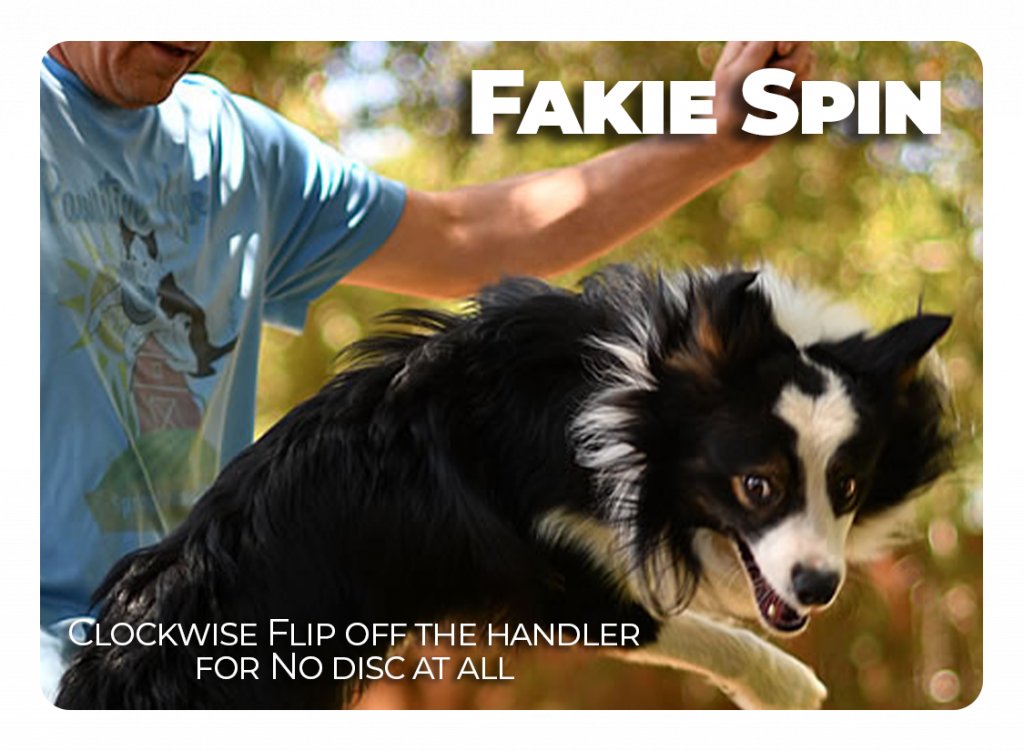
Fakie Spin
A Reverse Vault with No Disc Tossed

dog does a flip from the handler’s body similar to a flyball box turn, clockwise or counter clockwise, with no intent to catch a disc
This Skill has 4 Keys:
- drive and commitment
- pressure and posture
- clever then consequent reward placement
- verbal cue
Drive and Commitment
drive does not equal arousal. drive is energy that can be applied towards work. make sure that this skill is performed in a controlled manner.
This skill is often created by crazy dogs, and that’s cool. But this skill should not be a crazy skill. It should be controlled and measured performance that leads to clean and efficient landings that are funneled into the next trick.
That said, this skill does require drive and commitment. The dog needs to be willing to fly around off your body for a toy. Reinforcing with a bite or a roller is a pretty good idea.
Wait’s on both sides of this skill while learning and training it can be extremely helpful as can Attention (unsolicited eye contact Unsolicited eye contact or Attention is a great way to hook up with a dog. If you have something the dog wants he should give eye contact in order to get access to... More). Having the ability to turn this skill on and off is more than a bonus, it’s a necessity.
Unsolicited eye contact or Attention is a great way to hook up with a dog. If you have something the dog wants he should give eye contact in order to get access to... More). Having the ability to turn this skill on and off is more than a bonus, it’s a necessity.
Pressure and Posture
your dog goes where your shoulders are pointed and is more likely to get on you if you are leaning back. make sure you are sending the right signals.
Fakie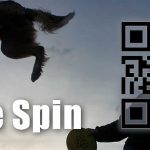 An athletic Set Up Move, the Fakie is a flip off of the handler's body (normally the chest) with no disc in flight or intended to be caught. It is usually named by... More Spin is a clockwise flip or spin
An athletic Set Up Move, the Fakie is a flip off of the handler's body (normally the chest) with no disc in flight or intended to be caught. It is usually named by... More Spin is a clockwise flip or spin Spins and Twists are tricks where the dog spins 360 degrees in a clockwise or counter clockwise fashion. Spin is clockwise and Twist is counter clockwise so it is important to have a... More off the handler’s body. The handler’s shoulders are a strong indicator of direction, so strong that dogs will often fail to target the disc at all, being overwhelmed by the power of the directional cue given by the handler’s shoulders. So, turn your shoulders in the direction in which you want the dog to go.
Spins and Twists are tricks where the dog spins 360 degrees in a clockwise or counter clockwise fashion. Spin is clockwise and Twist is counter clockwise so it is important to have a... More off the handler’s body. The handler’s shoulders are a strong indicator of direction, so strong that dogs will often fail to target the disc at all, being overwhelmed by the power of the directional cue given by the handler’s shoulders. So, turn your shoulders in the direction in which you want the dog to go.
Leaning forward and leaning back play around with pressure and pulling as well. Leaning forward exerts pressure and pushes the dog away; you’re applying the brakes. While leaning back pulls the dog in.
Clever and Consequent Reward Placement
the dog goes where the disc happens. if you always reward on you, with a bite, your dog will finish the spin and wind up facing you, promptly. rollers or throws push the dog away and can make the Fakie finish away from you.
Most of the time the Fakie finishes with the dog facing the handler, making it easier to hook up for another set up move Set Up Moves are tricks that are used to establish timing and position in disc dog freestyle. Traditional tricks include: Around, Through, Backwards Through, and Scoot, but any or all of your tricks,... More or a catch. Reinforcing with a Bite in your hand after this provides the handler some fine tuning knobs to dial in the position on the finish.
Set Up Moves are tricks that are used to establish timing and position in disc dog freestyle. Traditional tricks include: Around, Through, Backwards Through, and Scoot, but any or all of your tricks,... More or a catch. Reinforcing with a Bite in your hand after this provides the handler some fine tuning knobs to dial in the position on the finish.
Sometimes you may want your Fakie to be more of a rebound A Reverse Vault is a vault in which the dog flips off the handler’s body. The Reverse Vault, aka Rebound, can be done off of any part of the body, and the part... More or carom kind of a skill. Not a full spinny twisty things. If that’s the case, just use your Roller
A Reverse Vault is a vault in which the dog flips off the handler’s body. The Reverse Vault, aka Rebound, can be done off of any part of the body, and the part... More or carom kind of a skill. Not a full spinny twisty things. If that’s the case, just use your Roller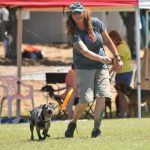 The Roller is a great throw for reinforcing a dog with a disc. Instead of flying through the air like a wing, the Roller rolls on the ground like a wheel; a fast,... More or throw with reward placement in mind.
The Roller is a great throw for reinforcing a dog with a disc. Instead of flying through the air like a wing, the Roller rolls on the ground like a wheel; a fast,... More or throw with reward placement in mind.
Verbalize and Fade the Physical Cue
this skill is easily accomplished with some prey driven luring and cuing. it is important to add a verbal cue and fade the physical cue so you can Fakie off of other parts of the body or even other objects.
If you want your dog to Fakie off of other parts of your body, you will need to have reduced reliance on your physical, prey driven cue. A simple way to do this is to use a simple prompt switch. A prompt switch is just changing the cue for the dog. Prompt SwitchA Prompt Switch is a technique for changing the cue or signal for a behavior. The new/weak cue is given, verbally or physically followed immediately by the old/strong cue. Then the behavior happens.... More = New or weak Cue followed by Old or strong Cue followed by reinforcement.
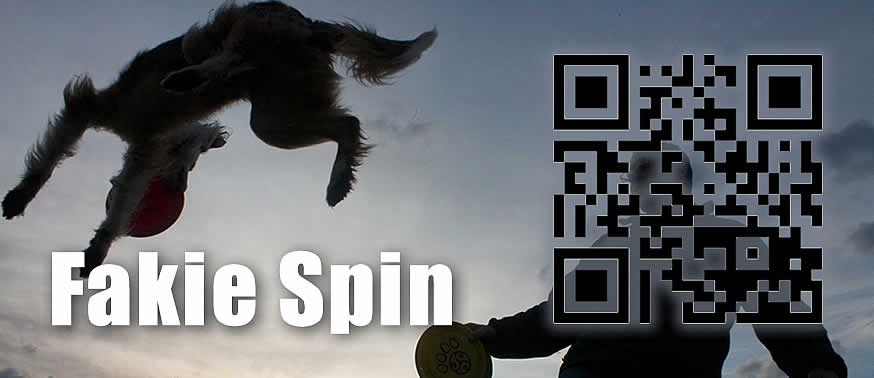
Give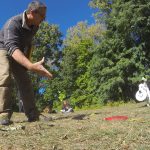 The Give is a retrieve to the hand. A cued Give is a foundational skill that is not super useful in the actual performance of disc dog freestyle, and has huge applications for... More your new verbal cue right before your physical cue. “Fakie” … [disc flashes]. Do that often enough and you can then just give your verbal cue and wait or give your verbal cue with a super lame and small physical cue. Your dog will hop to it in no time.
The Give is a retrieve to the hand. A cued Give is a foundational skill that is not super useful in the actual performance of disc dog freestyle, and has huge applications for... More your new verbal cue right before your physical cue. “Fakie” … [disc flashes]. Do that often enough and you can then just give your verbal cue and wait or give your verbal cue with a super lame and small physical cue. Your dog will hop to it in no time.



